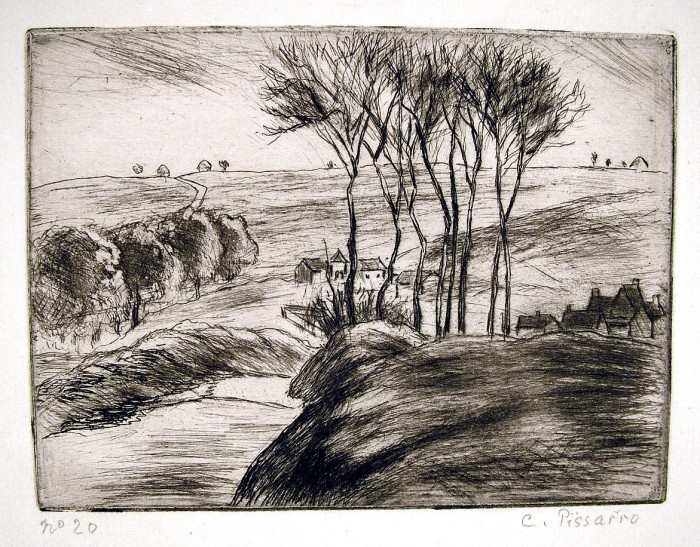Paysage a Osny

Camille Pissarro (1830-1903), Paysage a Osny, 1887, etching and drypoint, signed in pencil and numbered “20”. Reference: Delteil 70, first state of two. In very good condition, on heavy cream laid paper, the full sheet with very wide margins, 4 1/2 x 6 1/8, the sheet 16 3/4 x 23 1/16 inches. As published by L’Etampe Original, and with its blindstamp (Lugt 819) lower left margin. From the edition of 100.
A fine impression, with excellent contrasts, and the drypoint burr effective.
Paysage a Osny was published in its original edition in the first state; additional proofs were taken in a second state, and then in a posthumous edition. The second state posthumous prints are not comparable to our impression: they’ve lost their richness, many of the delicate drypoint lines have worn out; the print has a grey quality.
By the late 1880’s Pissarro had been making prints for many years, and printmaking was a critical part of his work (among the Impressionists Pissarro and Degas were exceptional in their involvement with printmaking). After an early period of learning about the rudiments of printmaking, and then an extended time of experimentation, working closely with Degas, he continued printmaking as a mature artist; Paysage a Osny was done in this latter phase of his career. But his work was always aesthetically ahead of his time. He noted in a letter to his son Lucien in 1891: “As for the collectors, I’ll tell you what they really admire – Charles Jacque, Buhot, Bracquemond, or Legros when he’s in his Rembrandt mood, and the same goes for Seymour Haden. But not printmaking dealing with sensations. And that’s what I’m trying to do with my feelings.”
His comments about printmakers in a “Rembrandt mood” notwithstanding, Pissarro was (of course) an admirer of Rembrandt, and Paysage a Osny bears a curious resemblance to one of Rembrandt’s most famous prints, The Three Trees, with the trees on a dark hill at the right of the composition, and a rather complex set of hills and patterns (although, in both prints, the composition seems at first innocent glance rather straightforward).